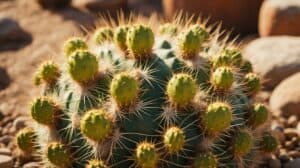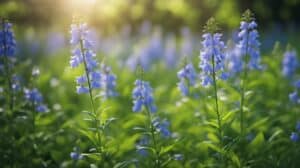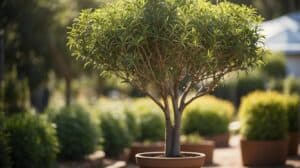Dendrobium Nobile is a beautiful and popular orchid species that is loved by many enthusiasts.
It is native to the Himalayas and other parts of Asia, and it is known for its stunning flowers that come in various colors and patterns.
If you’re new to orchid care and want to learn how to care for Dendrobium Nobile, then this article is for you.

One of the reasons why Dendrobium Nobile is a great orchid species for beginners is that it is relatively easy to care for.
It doesn’t require as much attention as some other orchid species, and it can thrive in a range of temperatures and humidity levels.
However, like all orchids, it still requires proper care and attention to ensure that it grows and blooms to its full potential.
In this article, you will learn about the basic care requirements for Dendrobium Nobile, including its light, water, temperature, and fertilizer needs.
You will also learn about common problems that can arise when caring for this orchid species, as well as tips for troubleshooting and resolving these issues.
By the end of this article, you will have all the information you need to care for Dendrobium Nobile and enjoy its beautiful blooms for years to come.
Understanding Dendrobium Nobile
Species Overview
Dendrobium Nobile is a species of orchid that belongs to the genus Dendrobium. It is native to the Himalayas, China, and Southeast Asia.
The plant has long, thin stems that can grow up to 1 meter in height. The stems are covered with small leaves that are about 2-3 cm in length.
The flowers of Dendrobium Nobile are usually white, pink, or purple and have a sweet fragrance.
Dendrobium Nobile is a popular orchid species among enthusiasts due to its beautiful flowers and ease of care.
It is also known as the “noble dendrobium” because of its regal appearance.
Natural Habitat
Dendrobium Nobile grows naturally in the Himalayas, China, and Southeast Asia.
It is typically found in mountainous regions at elevations of 1000-2000 meters. The plant prefers cool temperatures and high humidity levels.
In its natural habitat, Dendrobium Nobile grows on trees and rocks.
It is an epiphytic orchid, which means that it grows on other plants but does not rely on them for nutrients.
The plant obtains its nutrients from the air and rainwater that falls on its leaves and stems.
Overall, Dendrobium Nobile is a fascinating orchid species that is easy to care for and has a unique natural habitat.
With proper care, it can thrive and produce beautiful flowers for years to come.
Essential Care Guidelines

Lighting Requirements
Dendrobium Nobile orchids require bright but indirect light to thrive. Direct sunlight can damage their delicate leaves and flowers.
A good location for these orchids is near a window that receives morning or evening sun, but not the intense midday sun.
If natural light is not sufficient, artificial light can be used to supplement it.
A fluorescent light placed 6-12 inches above the orchid can provide the necessary light.
Watering Techniques
Overwatering is the most common cause of orchid death. Dendrobium Nobile orchids should be watered when the potting mix is almost dry.
The frequency of watering will depend on the temperature and humidity of the environment.
In general, these orchids require less water during the winter months when the temperature is cooler and the air is drier.
When watering, it is important to thoroughly saturate the potting mix and let the excess water drain away.
Temperature and Humidity Control
Dendrobium Nobile orchids prefer temperatures between 60-85°F during the day and 50-70°F at night.
They also require high humidity levels, ideally between 50-70%.
To maintain the necessary humidity, the orchid can be placed on a tray of pebbles filled with water.
The pot should not be in direct contact with the water, as this can lead to root rot.
Alternatively, a humidifier can be used to increase the humidity levels in the room.
Overall, by following these essential care guidelines, even the most enthusiastic beginner can successfully care for their Dendrobium Nobile orchids.
Propagation and Repotting

Propagation Methods
Dendrobium Nobile orchids can be propagated through division or stem cuttings. Division is the easiest and most common method.
It involves separating the orchid into two or more sections, each with their own set of roots and stems.
This can be done when the orchid has outgrown its pot or when it has multiple stems.
To divide the orchid, carefully remove it from its pot and gently separate the sections.
Make sure each section has at least three bulbs and a good root system.
Stem cuttings are another option, but they are more difficult and require more patience.
To take a stem cutting, choose a healthy stem with at least two nodes. Cut the stem just below the second node and remove any leaves or flowers.
Place the cutting in a container with moist sphagnum moss and keep it in a warm, humid location.
It may take several months for the cutting to develop roots and new growth.
Repotting Steps
Repotting should be done every 1-2 years, or when the orchid has outgrown its pot. To repot a Dendrobium Nobile orchid, follow these steps:
- Choose a pot that is slightly larger than the current pot.
Make sure it has drainage holes and is made of a breathable material, such as clay or plastic.
- Soak the orchid in water for 10-15 minutes to loosen the roots.
- Gently remove the orchid from its pot and carefully remove any old potting mix and dead roots.
- Trim any long or damaged roots with a pair of sterilized scissors.
- Place a layer of fresh potting mix in the bottom of the new pot.
- Position the orchid in the center of the pot and fill in the sides with potting mix, making sure the roots are covered but not buried too deeply.
- Water the orchid thoroughly and place it in a bright, indirect location.
By following these propagation and repotting guidelines, even the enthusiastic beginner can successfully care for a Dendrobium Nobile orchid.
Troubleshooting Common Issues

Pest Management
Dendrobium Nobiles are susceptible to a variety of pests, including spider mites, mealybugs, and scale insects.
To prevent infestations, regularly inspect your orchid for signs of pests, such as webbing or sticky residue on the leaves.
If you do find pests on your orchid, there are several steps you can take to manage the problem.
First, isolate the infected plant from your other orchids to prevent the pests from spreading.
Then, remove any visible pests with a cotton swab dipped in rubbing alcohol. Repeat this process every few days until the infestation is under control.
For more severe infestations, consider using an insecticidal soap or neem oil.
Be sure to follow the instructions carefully and avoid using these products in direct sunlight or on hot days.
Disease Prevention
Preventing disease is key to keeping your Dendrobium Nobile healthy.
One of the best ways to prevent disease is to maintain good air circulation around your orchid.
This can be achieved by placing a fan near your orchid or by keeping it in a well-ventilated area.
Another important aspect of disease prevention is proper watering.
Overwatering can lead to root rot, so make sure the potting mix is well-draining and allow the top inch of soil to dry out before watering again.
Additionally, avoid getting water on the leaves or flowers, as this can lead to fungal infections.
Addressing Leaf and Root Problems
If you notice yellowing or wilting leaves on your Dendrobium Nobile, it may be a sign of a root problem.
Carefully remove the orchid from its pot and inspect the roots. Healthy roots should be firm and white, while dead or rotting roots will be soft and brown.
If you find dead or rotting roots, carefully trim them away with sterile scissors and repot the orchid in fresh potting mix.
Be sure to water the orchid sparingly until it has had a chance to recover.
In addition to root problems, leaf problems can also occur.
If you notice brown spots or discoloration on the leaves, it may be a sign of fungal or bacterial infection.
Remove any affected leaves and treat the orchid with a fungicide or bactericide, following the instructions carefully.
By following these tips for pest management, disease prevention, and addressing leaf and root problems, you can keep your Dendrobium Nobile healthy and thriving.
Frequently Asked Questions

What are the ideal lighting conditions for a Dendrobium Nobile orchid?
Dendrobium Nobile orchids thrive in bright, indirect sunlight. They should be placed near a window that receives filtered light or under a sheer curtain.
Avoid direct sunlight, as it can burn the leaves. If the leaves turn yellow or brown, it may be a sign that the plant is getting too much light.
How often should I water my Dendrobium Nobile orchid?
Dendrobium Nobile orchids prefer moist but not waterlogged soil. Water the plant thoroughly once a week or when the top inch of soil feels dry.
Avoid overwatering, as it can lead to root rot. It’s also important to use room-temperature water to prevent shock to the plant.
What type of soil is best for potting Dendrobium Nobile orchids?
Dendrobium Nobile orchids prefer a well-draining potting mix that is high in organic matter. A mix of bark, perlite, and sphagnum moss is ideal.
Avoid using regular potting soil, as it can retain too much moisture and lead to root rot.
Can you explain the process of pruning a Dendrobium Nobile orchid?
Pruning a Dendrobium Nobile orchid involves cutting back the old, woody stems after they have finished blooming.
Use a clean, sharp pair of scissors or pruning shears to make a clean cut just above a node.
This will encourage the plant to produce new growth and bloom again next season.
What steps should I take to propagate Dendrobium Nobile orchids?
Dendrobium Nobile orchids can be propagated by dividing the plant at the roots. Wait until the plant has finished blooming and remove it from its pot.
Gently separate the roots and cut the stem into sections, making sure each section has at least one healthy growth point.
Repot each section into a well-draining potting mix and water thoroughly.
What should I do with my Dendrobium Nobile orchid after it finishes flowering?
After your Dendrobium Nobile orchid has finished flowering, continue to care for it as normal.
Cut back the old stems and fertilize the plant with a balanced fertilizer. Keep the plant in bright, indirect sunlight and water it as needed.
With proper care, your Dendrobium Nobile orchid will bloom again next season.














